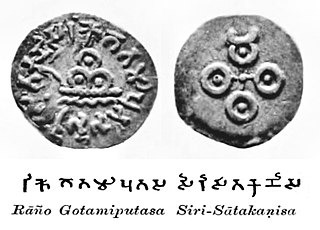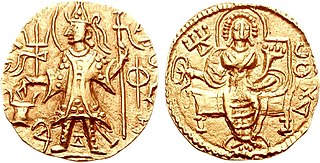
Amenemhat III, also known as Amenemhet III, was a pharaoh of ancient Egypt and the sixth king of the Twelfth Dynasty of the Middle Kingdom. He was elevated to throne as co-regent by his father Senusret III, with whom he shared the throne as the active king for twenty years. During his reign, Egypt attained its cultural and economic zenith of the Middle Kingdom.
Pulakeshin II populary known as Immadi Pulakeshi, was the greatest Chalukyan Emperor who reigned from Vatapi. During his reign, the Chalukya Empire expanded to cover most of the Deccan region in peninsular India.

Gautamiputra Satakarni was a ruler of the Satavahana Empire in present-day Deccan region of India. He was mentioned as the important and greatest ruler of Satavahana Dynasty. He ruled in the 1st or 2nd century CE, although his exact period is uncertain. His reign is dated variously: 86-110 CE, c. 103-127 CE, 106-130 CE, or more recently and specifically ca. 60-85 CE.
Kirttivarman I was a ruler of the Chalukya dynasty of Vatapi in India. He ruled parts of present-day Karnataka, Goa, Maharashtra and Andhra Pradesh.
Pulakeshin was the first sovereign ruler of the Chalukya dynasty of Vatapi. He ruled parts of the present-day Maharashtra and Karnataka states in the western Deccan region of India. Pulakeshin established the city of Vatapi, and performed the Ashvamedha sacrifice to assert his sovereign status. The dynasty established by him went on to rule a major part of peninsular India in the subsequent years.
Mangalesha was a king of the Chalukya dynasty of Vatapi in Karnataka, India. He succeeded his brother Kirttivarman I on the throne, and ruled a kingdom that stretched from southern Gujarat in north to Bellary-Kurnool region in the south, in the western part of the Deccan region. It included parts of present-day Gujarat, Maharashtra, Goa, Karnataka, and Andhra Pradesh.
The Ikshvaku dynasty ruled in the eastern Krishna River valley of India, from their capital at Vijayapuri for over a century during 3rd and 4th centuries CE. The Ikshvakus are also known as the Andhra Ikshvakus or Ikshvakus of Vijayapuri to distinguish them from their legendary namesakes.

The Kamboja-Pala dynasty ruled parts of Bengal in the 10th to 11th centuries CE, after invading the Palas during the reign of Gopala II. The last Kamboja ruler of the Kamboja-Pala Dynasty Dharmapala was defeated by the south Indian Emperor Rajendra Chola I of the Chola dynasty in the 11th century.
Rajyapala or Kamboja-Vamsa-Tilaka was the founder of the Kamboja Pala dynasty of Bengal. This dynasty had ruled over northern and western Bengal. Four rulers of this dynasty are known who ruled, either over north-west Bengal or parts thereof, from second half of tenth century to the first quarter of the 11th century. The last known king of Kamboja Pala dynasty was Dharmapala, who was the ruler in Dandabhukti division, during the first quarter of the 11th century.

Vāsishka was a Kushan emperor, who seems to have had a short reign following Kanishka II.

Narayanapala was the seventh emperor of the Pala dynasty of the Eastern regions of the Indian subcontinent, mainly the Bengal and Bihar regions.

Deva Dynasty was a Bengali Hindu dynasty which originated in the Bengal region of the Indian subcontinent; the dynasty ruled over eastern Bengal after the Sena dynasty. The capital of the dynasty was Bikrampur in present-day Munshiganj District of Bangladesh.
Sokkate was king of Pagan dynasty of Burma (Myanmar) from 1038 to 1044. The king lost his life in a single combat with Anawrahta, who succeeded him and went on to found the Pagan Empire.

Marduk-šāpik-zēri, inscribed in cuneiform dAMAR.UTU-DUB-NUMUN or phonetically -ša-pi-ik-ze-ri, and meaning “Marduk (is) the outpourer of seed”, reigned c. 1077–1065 BC, was the 7th king of the 2nd dynasty of Isin and 4th dynasty of Babylon and he ruled for thirteen years. His relationship with his predecessor, Marduk-nādin-aḫḫē is uncertain. His reign overlapped that of the Assyrian king Aššur-bēl-kala and his immediate predecessor(s) as the Synchronistic King List places him alongside both Tukultī-apil-Ešarra and Aššur-bēl-kala.

Ratna Pala was the son of Brahma Pala in Pala Dynasty (900–1100) of Kamarupa Kingdom. His queen's name was Durlabha. He was succeeded by Indra Pala.
Ganda was an early 11th century king of the Chandela dynasty of India. He ruled in the Jejakabhukti region. The exact period of his reign is uncertain, but has been dated approximately as 999-1002 CE.
Vijaya-chandra was an Indian king from the Gahadavala dynasty. He ruled the Antarvedi country in the Gangetic plains, which includes a major part of the present-day eastern Uttar Pradesh, including Varanasi. He probably also ruled some parts of western Bihar through his feudatories. He is believed to have repulsed a Ghaznavid invasion.
The Mathara dynasty ruled in the Kalinga region of eastern India during 4th and 5th centuries CE. Their territory included parts of the area between the present-day Ganjam district of Odisha in north and the Srikakulam district in Andhra Pradesh in the south. They appear to have been overthrown by the Pitrbhakta dynasty.
Adityavarman was a king of the Chalukya dynasty of Vatapi in southern India. He was a son of Pulakeshin II, who was defeated and probably killed when the Pallavas invaded and captured the Chalukya capital Vatapi. The immediate history of the dynasty after Pulakeshin's death is not clear, but inscriptions of Adityavarman and his son suggest that Adityavarman ruled a weakened Chalukya kingdom for a short period, before his younger brother Vikramaditya I defeated the Pallavas and restored the Chalukya power.

The Paramaras of Chandravati ruled the area around the Arbuda mountain in India during 10th-13th centuries. Their capital was located at Chandravati, and their territory included parts of present-day southern Rajasthan and northern Gujarat. The most notable ruler of the dynasty was Dharavarsha, who helped his Chaulukya overlords repulse a Ghurid invasion at the Battle of Kasahrada in 1178.









